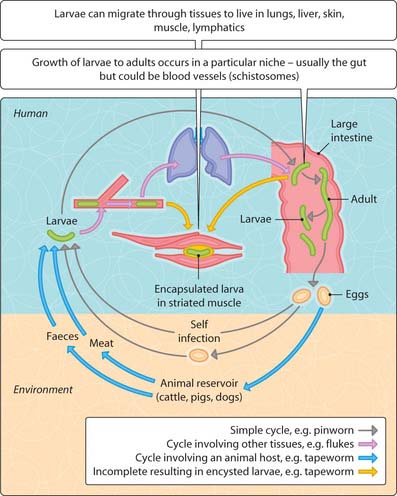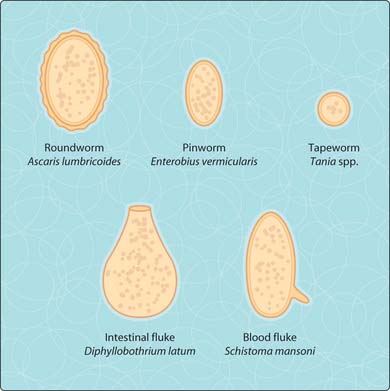47 Chemotherapy
anthelmintic agents
Parasitic helminths are complex multicellular organisms with nervous systems and organs and a life cycle that involves time spent in more than one host (Fig. 3.47.1). The helminths reproduce sexually in the primary definitive host (usually human but not always) to give rise to eggs or larvae, which then exit the host to continue their life cycle. In human infections, the eggs are distinctive and help to identify the parasite (Fig. 3.47.2). Parasitic helminths that infect humans form three groups: tapeworm (cestodes), roundworms (nematode) and flukes (trematode).
To be effective, an anthelminthic must be able to penetrate the cuticle of the worm or gain access to its alimentary tract. The route and dose is, therefore, important and must be chosen carefully since parasitic worms cannot be relied upon to consume sufficient amounts of the drug for it to be effective. An anthelminthic can act by causing paralysis of the worm or by damaging its cuticle, which can alert the host immune defences to remove the parasite. Drugs that interfere with the metabolism of the worm tend to be highly effective against one type of worm but ineffective against others (Table 3.47.1).
Table 3.47.1 Drugs Used In Helminth Infections
| Helminth | Drug |
|---|---|
| Cestodes | |
| Nematodes < div class='tao-gold-member'> Only gold members can continue reading. Log In or Register to continue
Stay updated, free articles. Join our Telegram channel
Full access? Get Clinical Tree
 Get Clinical Tree app for offline access
Get Clinical Tree app for offline access

|



